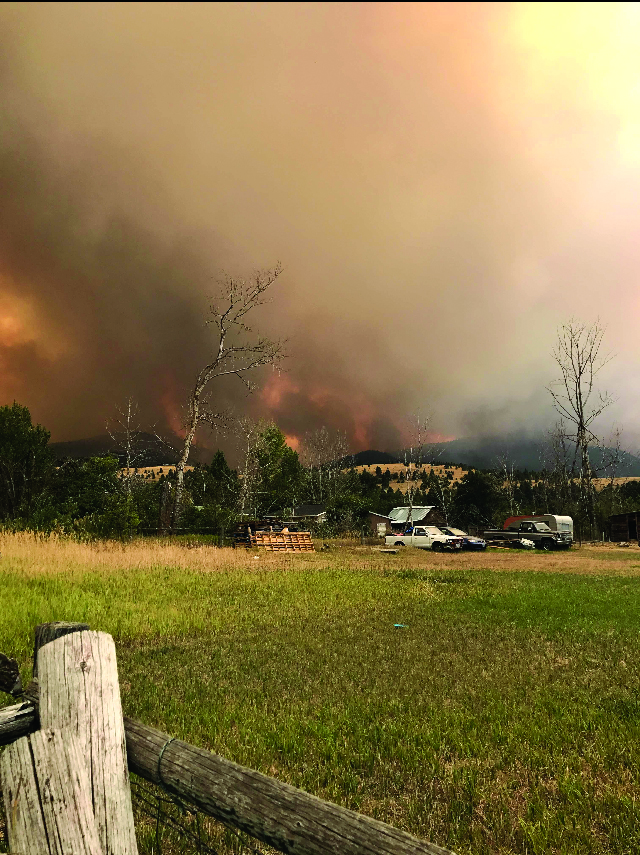Montana on Fire: Summer of Haze
October 10, 2017

Lolo Peak fire on the hill behind Zarah’s house.
After all these months the Lolo Peak Fire is still burning. The estimated date for the fire to be contained is on October 31st, 2017. By the time firefighters expect to be done, the fire will have burned for over 100 days.
The Lolo Peak Fire started on July 15 at about 2:34 pm by a lighting strike. Alongside the Lolo Peak Fire, the Rice Ridge Fire (North and East of Seeley Lake) has been burning since July 24 at about 4:30 pm according to an update from Inciweb, the Incident Information System.
Lolo Peak and Rice Ridge are the most expensive fires in Montana history, causing Montana to run out of fire funding. Lolo Peak is only 90% contained while Rice Ridge is 95% contained. (Contained is the percent of how much a fire is in control of by the firefighters)
Some Big Sky students live near the Lolo Peak fire, and have almost been evacuated. “All I could think about was packing my things and putting them in my car,” says junior Zarah Hafner. “I thought my house was going to burn down. My family and I were very nervous. It was very overwhelming.”
The smoke from the fires was bad enough to where people who lived by the fires were unable to go outside. “They told us to keep our animals inside at all times” Hafner shares, “and that if we are outside we have to get as far away as quick as we could.”
“That night my whole neighborhood saw the flames, it made people cry, panic, and get overwhelmed it’s just really sad and hurts.”

Lolo Peak fire on the hill behind Zarah’s house.
Many people including the Federal Emergency Management Agency (FEMA) agreed that the Rice Ridge fire was the most important fire burning. Considering the fire was only 8% contained and had burned over 120,000 acres, the public was worried about more evacuations. Luckily the rain came just in time, making the fire 61% contained as of September 19.
According to Inciweb, the Alice Creek fire has burned 29,252 Acres and is 80% contained. The fires started on Saturday July 22nd at about 6:37pm. The West Fork fire has burned 20,072 acres, and is 60% contained. The Alice Creek fire started on Saturday August 30th at around 10:45pm and has burned 29,252 acres and is 80% contained.
Alice Creek, Lolo Peak, West Fork, and rice Ridge were all caused by lightning strikes from dry lightning storms.
The smoke coming from all the fires in Montana affected certain people, including students. “The smoke can cause issues with people who have asthma and allergies; mainly students with sensitive bodies,” Danyelle Walker, Big Sky’s nurse shares.
The smoke didn’t only affect these kinds of students, but other students as well. “I’ve had a lot of students complaining of headaches more than dry throats,” Walker says “It could also be related to the smoke as well.”
Hafner adds “I don’t have asthma but I do have heart and lung problems that have gotten worse over time.”
Most students in Big Sky are more worried about the Lolo Peak fire. “The Lolo Peak worries me more than the others because of how much it’s burned,” said Senior Dakota Anderson.
Hafner added, “The Lolo peak fire is the scariest, because it’s the closest to my house”
Because of how much smoke there was in Missoula, everyone had to be prepared for anything. Walker shares, “It was mainly being prepared for if a student had a bad asthma attack. Luckily that never happened.”
On September 10, 2017 KPAX posted an article stating the following, “Three large Montana wildfires have been approved to receive disaster assistance from the Federal Emergency Management Agency (FEMA)” the next paragraph states “ FEMA will be releasing federal funds to help fight the Alice Creek Fire in Lewis and Clark County, the Rice Ridge Fire in Missoula and Powell Counties, and the West Fork Fire in Lincoln County”
FEMA started on June 19, 1978 and is used for natural disasters such as hurricanes, snowstorms, tornados, wildfires, and more. The headquarters is located in Washington, D.C. More information can be located at www.FEMA.gov
